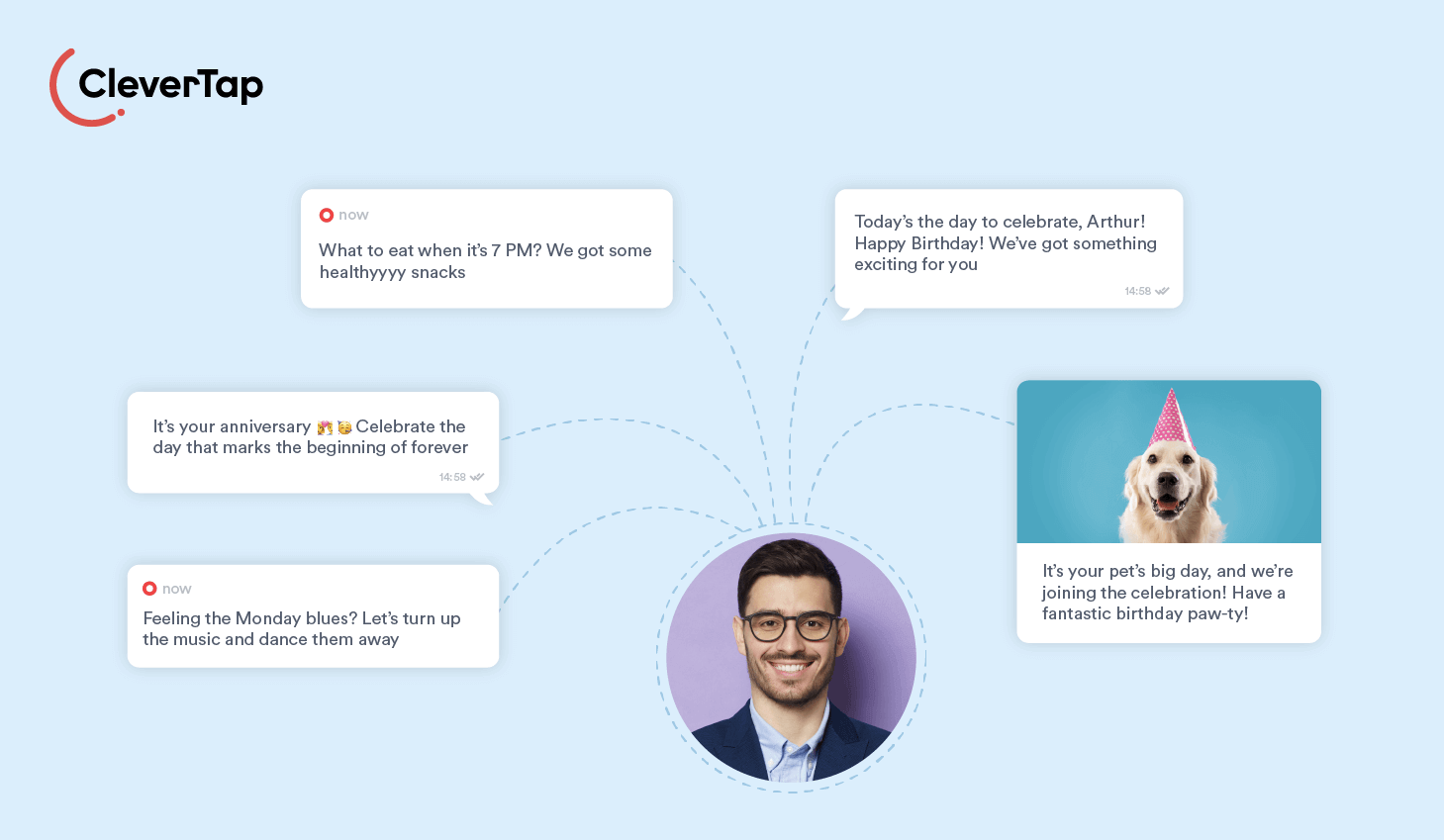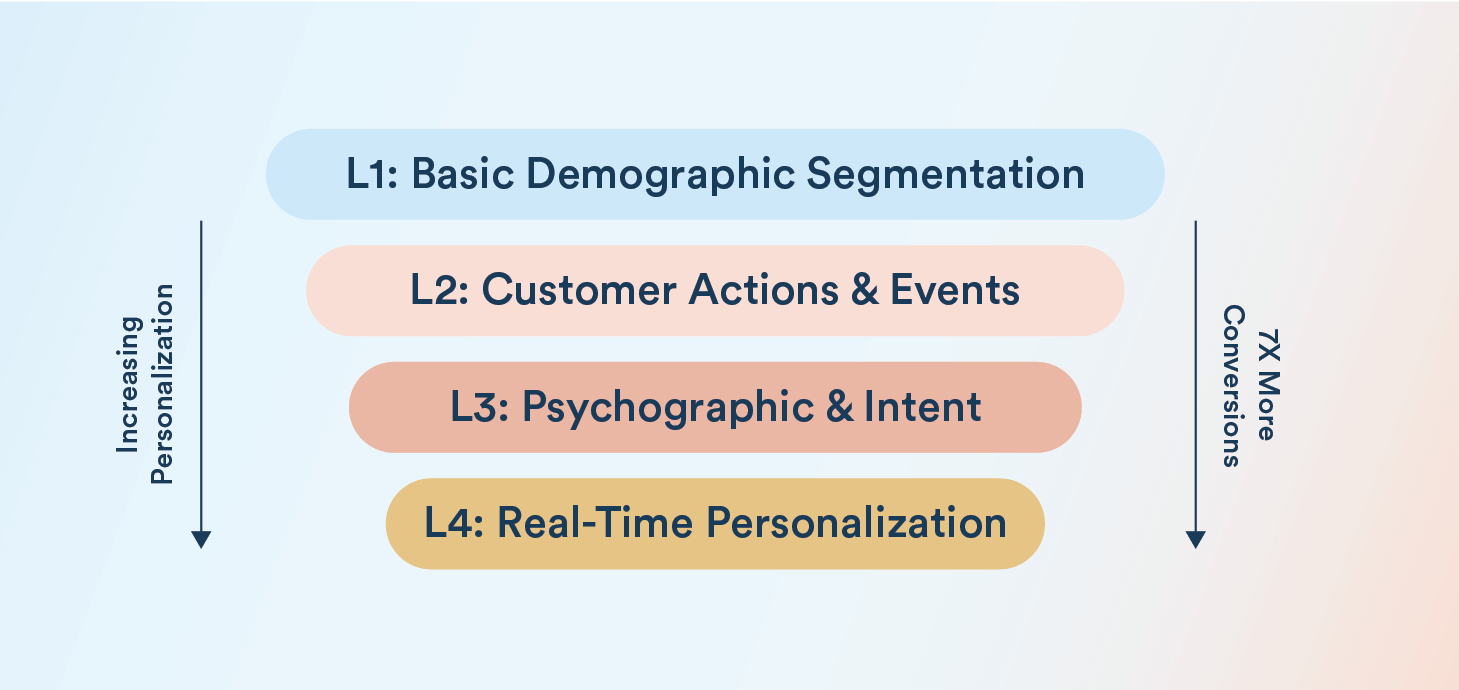Imagine having a conversation with a brand that knows your preferences like a close friend would. Here’s how personalization engines are turning data into meaningful interactions, making every customer feel uniquely seen and heard.
What is a Personalization Engine?
A personalization engine is an advanced software designed to customize content, products, and experiences to individual users based on their preferences and behaviors. It serves as a sort of digital concierge that understands what you like and need, sometimes even before you do.
Personalization engines use immense amounts of customer data to predict the kind of content their users want. Whether it’s suggesting the perfect pair of shoes, curating the ultimate playlist, or arranging a custom news feed, personalization engines allow brands to create relevant and enjoyable experiences that keep customers coming back.
Personalization Engine Benefits
Personalization engines have become a necessity for modern brands. Today’s consumers have become accustomed to a high degree of personalization, and they now expect experiences tailored to their unique preferences and needs. Businesses that deliver the most personalized interactions can stay a step ahead of their competitors and reap a myriad of benefits.
Increased Customer Engagement
Personalization engines can supercharge a brand’s customer engagement strategy by delivering content and recommendations that align with individual preferences. When users receive content that connects with their interests and preferences, they are more likely to interact with it. This leads to higher click-through rates, longer site visits, and increased overall engagement.
Better Conversion Rates
Personalization engines can directly influence purchasing decisions by presenting users with the right kind of products or content that matches their interests. This targeted approach has proven highly effective in converting browsers into buyers, boosting conversion rates and revenue growth. A personalized experience can be the difference in turning a casual visitor into a committed customer.
Enhanced Customer Loyalty
A highly personalized experience can create a deep sense of connection between a brand and its customers. Customers who feel seen and valued are more likely to return and keep engaging with the brand. Over time, this fosters customer loyalty, leading to repeat purchases and long-term relationships.
Better User Experience
Personalization engines streamline the user experience by reducing the effort required to find relevant content or products. By automatically surfacing what users are most interested in, these engines eliminate unnecessary steps and make interactions smoother and more satisfying.
Efficient Marketing Strategies
Personalization engines help companies target their marketing efforts more precisely. Businesses can harness user data to craft powerful campaigns that resonate with their intended audience in just the right way. This targeted approach reduces wasteful marketing efforts and increases the return on investment for marketing activities.
Higher Customer Lifetime Value
Sustainable growth isn’t just about the current transaction with a customer but how much that customer will purchase over the entirety of their relationship with your brand. A good personalization engine will also ensure higher customer lifetime value (CLV) by boosting customer engagement, conversion rates, and long-term loyalty. The reasoning is pretty straightforward: personalization engines lead to happier customers, and happier customers buy more.
Data-Driven Decision Making
Personalization engines provide businesses with valuable insights into customer behavior and preferences. These insights enable data-driven decision-making, allowing companies to refine their strategies and better meet customer needs. This continuous learning loop helps businesses stay agile and responsive in a rapidly changing market.
Types of Personalization

So, just how is personalization achieved? Well, personalization engines use a number of data points to curate the ideal experience and journey for each customer.
- Browsing History: This variable tracks the pages, articles, or products customers looked at during their visits. It’s like their digital footprint, showing what piques their interest over time. By analyzing patterns in what they’ve viewed, the personalization engine can predict and suggest similar content that aligns with their tastes. Customers are then introduced to new topics or products they hadn’t considered before.
- Purchase History: The record of items users have bought in the past is essential for tailoring future recommendations. It offers insight into their favorite brands or product types and helps the system suggest related or complementary items. If they regularly buy a certain category, the engine might highlight new arrivals or deals in that area. As a result, shopping becomes more convenient for customers and relevant to their habits.
- Demographic Information: This includes details like a customer’s age, gender, and location, providing a broad sense of who they are. By understanding their demographic profile, the system can adjust the content or products it shows them to better suit their lifestyle. For instance, someone in a warm coastal region might receive different recommendations than someone in a cold mountainous area, reflecting different needs or interests.
- Search Queries: The things users actively search for provide direct and immediate insight into their current interests or needs. These queries help the personalization engine quickly adapt to their present focus and offer suggestions aligned with what they’re looking for. If they often search for particular products, a personalization engine will preemptively display related items the next time they visit.
- Behavioral Data: This encompasses customer interactions, including clicks, scrolls, time spent on specific pages, and even hover actions. It’s similar to reading their digital body language to understand what grabs their attention or what they might find intriguing. Using these subtle cues, the system can refine the recommendations to better match their interests with engaging and relevant content.
- User Preferences: Sometimes, users make their likes or dislikes very clear through settings, ratings, or reviews. This direct feedback is incredibly valuable for personalization, as it allows the system to tailor the experience accordingly. Over time, these preferences help the engine refine its recommendations with content or products aligned with what users enjoy while avoiding the things they don’t.
- Device and Browser Type: Knowing whether a customer is accessing content from a smartphone, tablet, or desktop helps the system optimize what it shows them. Different devices call for different types of content or layouts; quick, digestible content is better for mobile, while more detailed information should be prioritized on a desktop. This ensures an excellent visual experience wherever they’re browsing.
- Time of Day: The timing of a user’s activity online can influence the types of recommendations they receive. For example, if they often browse in the evening, the system might suggest more leisure-oriented content, such as movies, books, or relaxation products. By adapting to the time of day, the engine can provide suggestions that fit naturally into their daily rhythm, enhancing the relevance of the content they see.
- Geolocation: A customer’s current or recent physical location adds a further contextual layer to personalization. If they’re near a particular store or in a specific city, the system might highlight local deals, events, or services that are geographically relevant. This not only makes the suggestions more useful but also helps them discover things that are immediately accessible or pertinent to their surroundings.
- Social Media Activity: Insights drawn from customers’ social media interactions, such as likes, shares, and follows, provide another rich source of data for personalization. This variable reflects their broader interests and social connections, helping the engine suggest content or products that align with their social identity. If they frequently engage with certain topics or influencers, they might see recommendations that resonate with their social circles. This makes their experience feel more connected and personalized to their online persona.
- Event-Based: Event-based personalization is triggered by specific actions or milestones in a customer’s journey, such as a birthday, an abandoned cart, or a recent purchase. Personalization engines respond to these events with timely and relevant suggestions, like sending a discount code for their birthday or reminding them of the items left in their cart. By recognizing and responding to these key moments, the system makes interactions feel more thoughtful and timely.
- Attribute-Based: This involves personalization based on specific attributes or characteristics a customer possesses, like being a premium member, a frequent traveler, or a new user. The system tailors content or offers based on these attributes, ensuring customers receive a more customized experience. A premium member might see exclusive offers or content, while a new user might be guided through onboarding materials. This approach helps provide a more targeted and appropriate experience based on their unique traits.
What to Look for in a Personalization Engine

When selecting a personalization engine, you need to ensure it aligns with your business goals and that it genuinely enhances your customers’ experiences. It should deliver recommendations in a smart, secure, and scalable way. To achieve this, here are some fundamental requirements to keep in mind:
Real-Time Adaptability: A personalization engine should continuously adapt its recommendations to reflect real-time user interactions. As it accumulates more information about user preferences, it can instantly adjust its suggestions.
Consistency Across Platforms: A good personalization engine would provide a cohesive experience wherever the user interacts with a brand, whether through an app, website, or other platforms.
Data Privacy and Security: In an age where data privacy is paramount, a personalization engine must effectively protect user data, ensuring that privacy is not compromised for the sake of personalization.
Scalability: As businesses grow and their user base expands, the personalization engine should grow with it, handling increasing data loads and more complex personalization needs.
Behavioral Analysis: The engine should be able to understand deeper behavioral tendencies, like when users are most likely to engage with the brand or make a purchase.
Content and Product Diversity: Personalization engines shouldn’t simply offer the most popular items. Instead, they should vary their recommendations to include lesser-known products that better match the user’s interests.
A/B Testing and Optimization: To ensure continuous improvement, the engine should be equipped with A/B testing, allowing businesses to experiment with different personalization strategies and adjust them based on performance data.
Personalization Engine Examples Across Various Industries
Personalization engines are revolutionizing various industries by tailoring experiences to meet individual customers’ unique preferences and needs. From retail to healthcare, these advanced systems enable companies to connect with their audiences more meaningfully, driving engagement, customer loyalty, and revenue.
In the retail industry, personalization engines transform the shopping experience by offering customized product recommendations based on past purchases, browsing history, and even real-time behavior. Retailers can create a highly personalized shopping journey by displaying relevant products, offering tailored promotions, and even adjusting content to match the shopper’s location or time of day. This not only enhances customer satisfaction but also significantly boosts conversion rates.
In entertainment, platforms like streaming services and digital media outlets use personalization engines to curate content that resonates with each user’s tastes. By analyzing viewing habits, search queries, and even social media interactions, these engines suggest content that is most likely to captivate the user. This leads to longer engagement times and stronger customer loyalty as users feel the platform understands their preferences.
The healthcare sector is also leveraging personalization engines to optimize patient treatment. They provide patients with customized health recommendations, medication reminders, and even personalized wellness plans. By integrating data from a patient’s medical history or a wearable device, healthcare providers can offer more precise and effective treatments. This improves patient outcomes and enhances the overall patient experience by making healthcare more personalized and proactive.
In the financial services industry, personalization engines help banks and financial institutions offer tailored advice and product recommendations. By analyzing customer financial behavior, transaction history, and personal goals, these engines can suggest financial products that align with the individual’s economic situation. This personalized approach builds trust and encourages long-term customer relationships.
Even in education, personalization engines are making a significant impact by creating customized student learning experiences. Educational platforms can use these engines to adjust content delivery based on a student’s learning style, pace, and performance. This tailored approach helps students stay engaged, improves learning outcomes, and supports a more effective educational experience.
CleverTap: The Ultimate Personalization Engine

Successful personalization requires more than just surface-level insights; it demands a sophisticated blend of advanced technologies that can work together to deliver personalized experiences at scale.
This is where CleverTap, powered by its innovative AI capabilities and cutting-edge data infrastructure, truly stands out. CleverTap’s personalization engine operates across four levels, each offering unique value and tailored use cases for e-commerce. Here’s how it works:
Level 1
At this level, CleverTap leverages demographic data such as age, gender, and location to deliver targeted recommendations and promotions. It ensures your content resonates with different customer segments. For instance, promoting winter gear to customers in colder climates or advertising local events to users in specific cities makes your marketing efforts more relevant and effective.
Level 2
Behavior-based segmentation comes into play here, CleverTap crafts messages based on customer actions like browsing history or purchase behavior. Personalized recommendations and re-engagement campaigns—such as reminding users about abandoned carts or promoting clearance items at nearby stores—help enhance the overall customer experience and drive more conversions.
Level 3
At this stage, CleverTap predicts customer preferences and intent, tailoring offers to match their interests and likely future behaviors. Fashion lovers might receive trend-based recommendations, while tech enthusiasts are shown the latest gadgets. By aligning content with specific psychographic profiles, you can create deeper customer connections and foster lasting loyalty.
Level 4
The fourth and final level harnesses real-time data to trigger immediate, highly relevant messages based on live customer actions. Event-driven campaigns, like highlighting trending products or limited-time offers, build a sense of urgency, encouraging quick purchases. Real-time personalization ensures every interaction is timely and engaging, offering a seamless shopping experience.
By implementing all four levels, CleverTap makes shopping more personal, driving stronger engagement and higher conversions. Our data shows that progressing from basic demographic targeting (Level 1) to advanced, real-time personalization (Level 4) dramatically boosts conversion rates, highlighting the power of a fully comprehensive personalization strategy.

Conclusion
Now that you’ve explored the ins and outs of personalization engines, you can start thinking about how to leverage these powerful tools to create deeper connections with your customers. Whether you’re a small business looking to enhance customer loyalty or a large enterprise seeking to optimize user experience at scale, a well-chosen personalization engine can be a game-changer.
Going forward, consider your business’s specific needs and how the different variables and features of a personalization engine can align with your goals. As you implement these strategies, remember that personalization isn’t just about pushing products—it’s about building relationships and delivering experiences that make customers feel valued and understood.
Stay ahead of the curve and set your business up for long-term success with CleverTap. Learn more about our advanced personalization capabilities or contact us for a personalized demo. The better you know your customers, the more effectively you can meet their needs. So take what you’ve learned here and start crafting experiences that truly resonate.
Agnishwar Banerjee 
Leads content and digital marketing.Expert in SaaS sales, marketing and GTM strategies.
Free Customer Engagement Guides
Join our newsletter for actionable tips and proven strategies to grow your business and engage your customers.















































